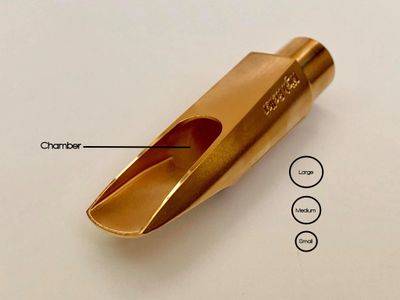Chamber Size
From the tip of the mouthpiece, the baffle and floor extend into the chamber as shown in the photo. Not only are there different chamber sizes, but there are different chamber shapes. The most common shape is a Round Chamber. Bullet, Oval, Square and Horseshoe Chambers are also used. These unique shapes will add different levels of resistance, fullness, and color in the sound.
- Small Chamber: will increase the airspeed creating a more compact sound and brighter tone. A small chamber is slightly smaller than the bore of the mouthpiece. Small chambers will also create more focus and response, but are not as free blowing as a medium or large chamber. The volume of air that transitions into a smaller opening will cause more resistance and back pressure.
- Medium Chamber: is between a small and large chamber, a perfect blend of color and resistance. A medium chamber will be the same diameter as the bore of the mouthpiece. In my opinion, medium chambers give you the most even and balanced sound. The volume of air passing through the chamber and bore is completely uniform.
- Large Chamber: will slow down the airspeed producing a darker tone. A large chamber is larger than the bore of the mouthpiece. Large chambers are free blowing and tend to have a more spread and fuller sound due to the size of the chamber in relation to the bore. The volume of air that transitions into a larger opening will have less resistance and back pressure.

Westcoast Sax
Panama City, Florida 32404
